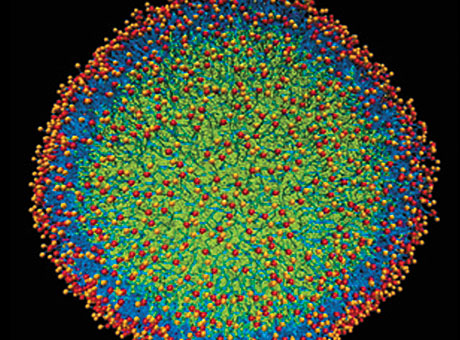
A computer simulation of a nanoparticle showing its core of perfluorocarbon (green) and its lipid coating (red, orange and blue).

A computer simulation of a nanoparticle showing its core of perfluorocarbon (green) and its lipid coating (red, orange and blue).
A proposal to develop a vaginal gel that affords both contraception and HIV protection using nanoparticles that carry bee venom has won a 2010 Grand Challenges Explorations grant from the Bill & Melinda Gates Foundation.
Samuel A. Wickline, MD, professor of medicine, of cell biology and physiology, and of physics and biomedical engineering, leads the effort and has assembled a multidisciplinary team of collaborators to carry out proof-of-concept activities for the grant.
“Sperm and HIV are remarkably similar in their natural mechanism of genetic transmission,” Wickline says. “Both need to fuse with their target cell in order to deliver their genetic payloads — DNA in the case of sperm, and RNA in the case of HIV.”
Wickline’s plan is to use the very means by which sperm and HIV operate to destroy them. “The idea is to trick each to fuse with a synthetic Trojan Horse — a nanoparticle that will overwhelm sperm and HIV in numbers and in destructive power.”
The Trojan Horse, or decoy, that will be used to attract the sperm and HIV is a lipid nanoparticle created by Wickline and colleague Gregory M. Lanza, MD, PhD, professor of medicine, that has already been proven safe for clinical use.
The nanoparticles will carry a synthetic version of bee toxin, called melittin, to the targets. Since melittin can annihilate almost any cell, the trick is to target the melittin to the specific cells intended for destruction without causing collateral damage.
Wickline and Paul H. Schlesinger, MD, PhD, associate professor of cell biology and physiology, attacked that problem two years ago when they developed “nanobees,” nanoparticles that sequester melittin so that it neither harms healthy tissue nor is degraded before reaching its target.
To destroy the sperm, Wickline intends to target a well-known “docking site” on the sperm cap. Sperm cells, which are roughly 160 times bigger than the 250-nanometer particles, will be swarmed with nanobees.
HIV virions, which are less than half the size of the nanoparticle, will be captured and destroyed with special molecules attached to the nanobees that bind to complementary molecules on the virion that play a role in initiating HIV fusion to cells.
The nanoparticles will remain on site inside the vaginal vault until washed out by the body’s natural fluids.